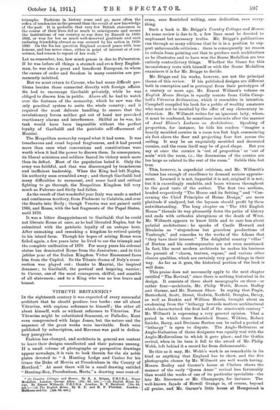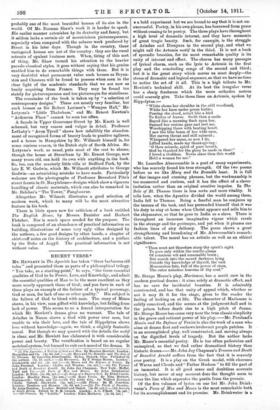VITRUVII BRITANNICI.* IN the eighteenth century it was expected of
every successful architect that he should produce two books : one all about Vitruvius, with copious reference to himself ; the other all about himself, with or without reference to Vitruvius. For Vitruvius might be substituted Scamozzi, or Palladio; Kent even compromised with Inigo Jones, but the nature and the sequence of the great works were inevitable. Both were published by subscription, and Maecenas was paid in dedica- tory panegyrics.
Fashion has changed, and architects in general are content to leave their designs uncollected and their patrons unsung. If a small volume of photographs or perspective drawings appear nowadays, it is vain to look therein for the six noble plates devoted to "A Hunting Lodge and Casino for his Grace the Duke of Mercia at Proudenham in the County of Hertford." At most there will be a small drawing entitled "Hunting-Box, Prondenham, Herta," a drawing sans coat-of- * (1) Country Cottages and Homes. By IL A. Briggs, F.R.I.B.A., Soane Medallist. London, George Allen. [Ws. Bd. net.]—(2) English House De- awn. By Ernest Willmott, London, B. T. Botsford. [10s. 8d. net.)—(3) The English Horne. By B. F. and H. P. Fletcher. London Methuen and Co. [12a. 64. net.]
arms, sans flourished writing, sans dedication, sans every- thing.
Such a book is Mr. Briggs's Country Cottages anti Homes. As some review is due to it, a few lines must be devoted to unpleasant but necessary truths. Mr. Briggs's publications run through so many editions that be is in a position to sup- port unfavourable criticism ; there is consequently no reason to refrain from pointing out that to produce such architecture as be illustrates and to have won the Soane Medallion are two entirely contradictory things. Whether the blame for this inconsistency rests with himself or with the Soane Medallion examiners it is for Mr. Briggs to decide.
Mr. Briggs and his works, however, are not the principal theme of this review. If his published designs are different both in conception and in portrayal from their prototypes of a century or more ago, Mr. Ernest Willmot's volume on English House Design is equally remote from Colin Camp- bell's Vitruvius Britannicus, which it resembles in intention.
Campbell compiled his book for a. public of wealthy amateurs who must not be insulted by the offer of any elementary in- struction. Mr. Willmott writes for an ignorant laity, whom, it must be confessed, he sometimes instructs after the manner of Aunt Elinor's Lectures on Architecture. Speaking of proportion, for instance, he bids his readers "imagine a heavily moulded cornice in a room ten feet high commencing six feet above the floor and projecting four feet across the ceiling. It may be an exquisitely moulded and decorated cornice, and the room itself may be of good shape. But you say at once the cornice is 'out of proportion' or 'out of scale' with the room, i.e., the dimensions of the cornice are too large as related to the rest of the room." Subtle this, but true.
This, however, is superficial criticism, and Mr. Willmott's volume has enough of excellence to demand serious appraise- ment. Learned it is not, impartial it is not, original it is not; but it is exceedingly readable, and bears witness throughout to the good taste of the author. The first two sections, headed respectively "The House and its Setting" and "Con- cerning the Chief Principles of House Design," are mere platitude if analysed, but the layman should profit by them notwithstanding. The long chapter on "The Old English House" threads its way pleasantly down the paths of history and ends with orthodox abruptness at the death of Wren.
Mr. Willmott appears to know little and to care less about palatial architecture : he speaks of Castle Howard and Blenheim as "stupendous but graceless productions of Vanbrugh," and concedes to the works of the Adams that "they have their interest." The delightful country " villas " of Burton and his contemporaries are not even mentioned.
In fact, like most modern architects he makes his business the pursuit of "charm, texture, repose," and various other elusive qualities, which are certainly very good things in their way. As far as it goes, the historical portion of the book is well done.
This praise does not necessarily apply to the next chapter entitled "The Revival," since there is nothing historical in its design. It consists of three short monographs on three—or rather four—architects, Mr. Philip Webb, Messrs. Bodley and Garner, and Mr. Norman Shaw. In saying that Pugin, Butterfield, Scott, Street, Godwin, Nesfield, Douglas, Devey, as well as Ruskin and William Morris, brought about an awakening from the "lethargy towards matters architectural which characterized the first half of the nineteenth century" Mr. Willmott is expressing a very general opinion. That a period in which there flourished Soane, Wilkins, Robert Smirke, Barry, and Decitnus Burton can be called a period of "lethargy" is open to dispute. The Anglo-Hellenism or Anglo-ltalianism of these designers was equally real with the Anglo-Medivalisra to which it gave place ; and the Gothic revival, when in its turn it. fell to the sword of Mr. Philip Webb, left behind it a record far from dishonourable.
Be this as it may, Mr. Webb's work is as remarkable in its kind as anything that England has to show, and the five photographs chosen by Mr. Willmott are well worth having. Messrs. Bodley and Garner's house at Chelsea shows the manner of the early "Queen Anne" revival less favourably than would the works of one of its particular specialists—the late Mr. Stevenson or Mr. Champneya, for instance. The well-known ,facade of Hewell Grange is, of course, beyond all praise, and Mr. Garner's little house at Hampstead is probably one of the most beautiful houses of its size in the world. Of Mr. Norman Shaw's work it is harder to speak. His earlier manner astonishes by its dexterity and fancy, but it seldom lacks a certain air of meretricious picturesqueness, especially when compared with the soberer work produced by Street in his later days. Though in the country, these variegated houses are not of the country : they are the rural retreats of opulent business men. When, tiring of this sort of thing, Mr. Shaw turned his attention to the heavier pseudo-classical styles, it goes without saying that his genius enabled him to do remarkable things with them. But it is very doubtful what permanent value such houses as Bryan- ton and Cheaters will be found to possess when seen in the clear light of the academic standards that we are now so busily acquiring from France. They may be found too stately for picturesqueness and too picturesque for stateliness.
The remainder of the book is taken up by "a selection of contemporary designs." These are mostly very familiar, but such houses as Sir Robert Lorimer's " Wemyss Hall," Mr- Lutyens's "Little Thakeham," and Mr. Ernest Newton's " Ardenrun Place" cannot be seen too often.
A facade in Upper Grosvenor Street by Mr. Knott is well schemed, but very coarse and vulgar in detail. Professor Lethaby's "Avon Tyrell" shows bow infallibly the abandon- ment of recognized forms of beauty leads to positive ugliness, and a house in Hampshire by Mr. Willmott himself is, for some curious reason, in the Dutch style of South Africa. Mr. Lutyens's work, as usual, puts most of the rest to shame, though the house at Streatham by Mr. Ernest George, now many years old, can hold its own with anything in the book. So, too, can the masterly little villa at Bedford Park, by the late E. W. Godwin, which Mr. Willmott attributes to George Godwin--an astonishing mistake to have made. Particularly welcome are the photographs of Professor Beresford Pite's street fronts in St. Marylebone—designs which show a vigorous handling of classic materials, which can also be remarked in Mr. Bekher's "The Tower," Pangbourne.
Altogether Mr. Wilmott illustrates a good selection of modern work, which to many will be the most attractive feature in his book.
There is little space now for criticism of a book entitled The English Home, by Messrs. Banister and Herbert Fletcher. Nor is much space needed for the purpose. The book is composed of an abundance of practical information on building, illustrations of some very ugly villas designed by the authors, a few good designs by other hands, a chapter of shirt-cuff notes on the history of architecture, and a preface by the Duke of Argyll. The practical information is not without value.



















































 Previous page
Previous page